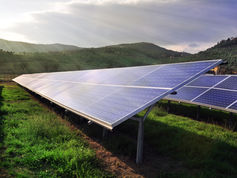Colombia's Utility PV Potential
- Otto Gunderson

- May 13
- 3 min read
Colombia, which generates nearly 70% of its electricity from renewable sources, has made significant strides in decarbonization over the past few years. However, the country's electricity matrix remains heavily dependent on hydropower. While this has proven critical for economic development thus far, there are several drawbacks to relying heavily on hydropower. These include the difficulty of building a transmission infrastructure from such a centralized source and the impacts of climate change, which have led to droughts in the country.
By harnessing the country's vast solar potential, Colombia can provide power to rural communities, reduce its reliance on a single form of electricity generation, and lower carbon emissions nationwide. In a country with strong radiation, significant demand, and wide tracts of available land, it is no surprise that PV could jump to almost a quarter of the total electricity matrix by 2037. Despite these positive factors, solar energy still represents a small fraction of Colombia's energy matrix.
The Colombian government has made significant efforts in recent years to encourage the development of renewable generation projects. One of these tools has been creating an auction platform to promote the development of solar farms. Additionally, new legislation, such as Law 1715, put in place in 2014, provides deductions and exemptions for nonconventional energy sources. Investment credits were then put in place by Law 2099 in 2021 to provide financial incentives for renewable energy investments. Most comprehensively, the National Development Plan, running from 2022 to 2026, emphasizes the development of renewable energy growth and creating an equitable transition.
These new government initiatives have already spelled success in the development of projects such as the Zelestra plant in Montería and the Shangri-La plant in Tolima Department. The Zelestra farm, 144 MW, can power 80,000 homes, while the completed Shangri-La project can power 200,000. The Shangri-La project, which is owned by Atlas Renewable Energy, represents the entrance of a major solar developer in Latin America into Colombia.

When asked about the opportunities for PV in the country, Esteban Uauy, Global Head of Structured Finance at Atlas Renewable Energy, described the growing interest around solar and battery storage in the country. He also touched on the capital stack that has worked in the past, including leveraging development banks and localized insurers. This was further reiterated by Rubén Borja, the Managing Director for Atlas Renewable Energy in Colombia, who explained how the Shangri-La project used a combination of financiers, such as Bancolombia and the Inter-American Development Bank, to raise the necessary capital.
The availability of funding was discussed during a conversation with Charlie Lopez Guirado, a Finance Manager at CSCI Colombia Solar. As Lopez Guirado described, international investors in China, the US, and the EU have shown strong interest in the Colombian Solar Market due to high investment returns, but many of the projects continue to face regulatory roadblocks. The combination of streamlined government approval processes with international capital could spur significant growth in the industry.

While government policies and strong rates of return have prompted international investment in the country, this is not without risk. Uauy described the difficulties of investing capital in US dollars for assets in Colombia due to the possibility of the value of the investment shifting along with the value of the currency. Stability in the Colombian Peso is, therefore, key to attracting foreign investment. As Borja then explained, the growth of solar will only be possible through available long-term investment, and this requires guarantees and public policies that can ensure stability.
With strong natural resources and a government that has passed significant legislation to encourage solar, utility-scale PV is poised for growth. However, in order to attract key international investment, the government must ensure stability and encourage long-term investment. By doing so, Colombia can continue to utilize its natural resources while shifting from its current hydropower reliance. A new energy matrix, with solar playing a much larger role, looks to be in the future.











Don't ignore the significant amount of Hydro provides to grid stability...if you shift too much to PV you'll likely be confronted with network stability problems as recently demonstrated in Spain's widespread national outage.